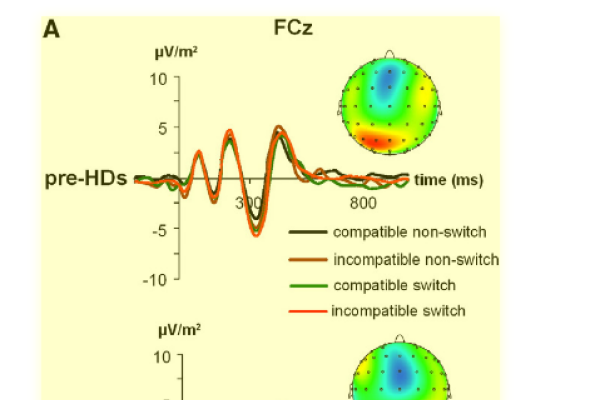2012-05-14

Flexible response adaptation and the control of conflicting information play a pivotal role in daily life. Yet, little is known about the neuronal mechanisms mediating parallel control of these processes. We examined these mechanisms using a multi-methodological approach that integrated data from event-related potentials (ERPs) with structural MRI data and source localisation using sLORETA. Moreover, we calculated evoked wavelet oscillations. We applied this multi-methodological approach in healthy subjects and patients in a prodromal phase of a major basal ganglia disorder (i.e., Huntington's disease), to directly focus on fronto-striatal networks. Behavioural data indicated, especially the parallel execution of conflict monitoring and flexible response adaptation was modulated across the examined cohorts. When both processes do not co-incide a high integrity of fronto-striatal loops seems to be dispensable. The neurophysiological data suggests that conflict monitoring (reflected by the N2 ERP) and working memory processes (reflected by the P3 ERP) differentially contribute to this pattern of results. Flexible response adaptation under the constraint of high conflict processing affected the N2 and P3 ERP, as well as their delta frequency band oscillations. Yet, modulatory effects were strongest for the N2 ERP and evoked wavelet oscillations in this time range. The N2 ERPs were localized in the anterior cingulate cortex (BA32, BA24). Modulations of the P3 ERP were localized in parietal areas (BA7). In addition, MRI-determined caudate head volume predicted modulations in conflict monitoring, but not working memory processes. The results show how parallel conflict monitoring and flexible adaptation of action is mediated via frontostriatal networks. While both, response monitoring and working memory processes seem to play a role, especially response selection processes and ACC–basal ganglia networks seem to be the driving force in mediating parallel conflict monitoring and flexible adaptation of actions.

Flexible response adaptation and the control of conflicting information play a pivotal role in daily life. Yet, little is known about the neuronal mechanisms mediating parallel control of these processes. We examined these mechanisms using a multi-methodological approach that integrated data from event-related potentials (ERPs) with structural MRI data and source localisation using sLORETA. Moreover, we calculated evoked wavelet oscillations. We applied this multi-methodological approach in healthy subjects and patients in a prodromal phase of a major basal ganglia disorder (i.e., Huntington's disease), to directly focus on fronto-striatal networks. Behavioural data indicated, especially the parallel execution of conflict monitoring and flexible response adaptation was modulated across the examined cohorts. When both processes do not co-incide a high integrity of fronto-striatal loops seems to be dispensable. The neurophysiological data suggests that conflict monitoring (reflected by the N2 ERP) and working memory processes (reflected by the P3 ERP) differentially contribute to this pattern of results. Flexible response adaptation under the constraint of high conflict processing affected the N2 and P3 ERP, as well as their delta frequency band oscillations. Yet, modulatory effects were strongest for the N2 ERP and evoked wavelet oscillations in this time range. The N2 ERPs were localized in the anterior cingulate cortex (BA32, BA24). Modulations of the P3 ERP were localized in parietal areas (BA7). In addition, MRI-determined caudate head volume predicted modulations in conflict monitoring, but not working memory processes. The results show how parallel conflict monitoring and flexible adaptation of action is mediated via frontostriatal networks. While both, response monitoring and working memory processes seem to play a role, especially response selection processes and ACC–basal ganglia networks seem to be the driving force in mediating parallel conflict monitoring and flexible adaptation of actions.